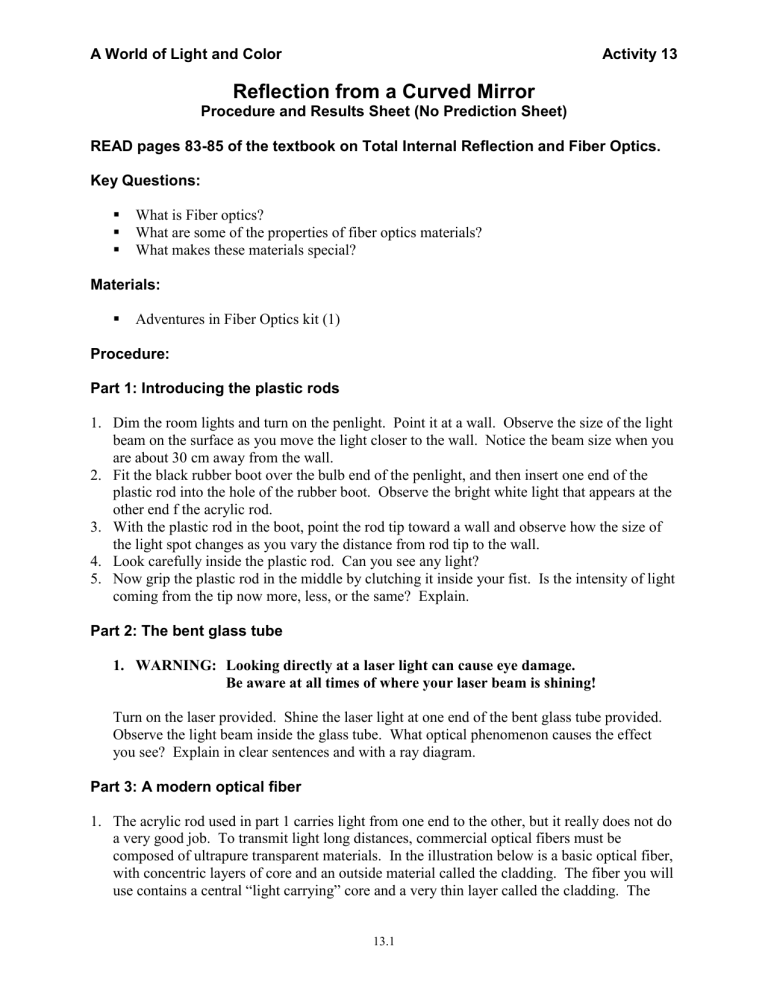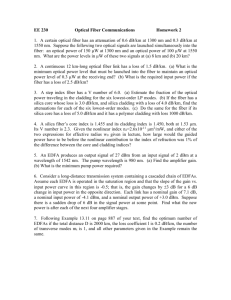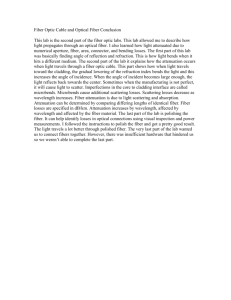Activity 13: Fiber Optics- Predictions and Results Sheet

A World of Light and Color
Reflection from a Curved Mirror
Activity 13
Procedure and Results Sheet (No Prediction Sheet)
READ pages 83-85 of the textbook on Total Internal Reflection and Fiber Optics.
Key Questions:
What is Fiber optics?
What are some of the properties of fiber optics materials?
What makes these materials special?
Materials:
Adventures in Fiber Optics kit (1)
Procedure:
Part 1: Introducing the plastic rods
1.
Dim the room lights and turn on the penlight. Point it at a wall. Observe the size of the light beam on the surface as you move the light closer to the wall. Notice the beam size when you are about 30 cm away from the wall.
2.
Fit the black rubber boot over the bulb end of the penlight, and then insert one end of the plastic rod into the hole of the rubber boot. Observe the bright white light that appears at the other end f the acrylic rod.
3.
With the plastic rod in the boot, point the rod tip toward a wall and observe how the size of the light spot changes as you vary the distance from rod tip to the wall.
4.
Look carefully inside the plastic rod. Can you see any light?
5.
Now grip the plastic rod in the middle by clutching it inside your fist. Is the intensity of light coming from the tip now more, less, or the same? Explain.
Part 2: The bent glass tube
1.
WARNING: Looking directly at a laser light can cause eye damage.
Be aware at all times of where your laser beam is shining!
Turn on the laser provided. Shine the laser light at one end of the bent glass tube provided.
Observe the light beam inside the glass tube. What optical phenomenon causes the effect you see? Explain in clear sentences and with a ray diagram.
Part 3: A modern optical fiber
1.
The acrylic rod used in part 1 carries light from one end to the other, but it really does not do a very good job. To transmit light long distances, commercial optical fibers must be composed of ultrapure transparent materials. In the illustration below is a basic optical fiber, with concentric layers of core and an outside material called the cladding. The fiber you will use contains a central “light carrying” core and a very thin layer called the cladding. The
13.1
cladding is only 10
m thick and is used to trap the light inside. The cladding is also transparent and you probably will not be able to distinguish it from the core.
2.
Insert one end of the 2 mm diameter fiber into the rubber boot, and point the fiber end at a nearby wall. Grip the middle portion of the fiber in your fist. Does the light coming out of the fiber’s tip increase, decrease or stay the same in intensity? How does this compare with what happened when you gripped the 3 mm diameter plastic rod? Explain in clear sentences.
Part 4: Special optical effects using fibers
1.
Cut the fiber end at an angle. What happens to the light coming out of it? Describe in a complete sentence.
2.
Coil the fiber around a spool and heat it with a blow dryer. What happens when the fiber cools down? Describe in a complete sentence.
3.
Lightly create very small nicks in the fiber’s cladding with a razor blade or sharp knife.
Describe in a complete sentence.
4.
Place a small drop of hot glue on the fiber tip and attach a small piece of aluminum foil to the glue while it is still hot. Describe in a complete sentence.
Part 5: A rock called Ulexite
1.
Long before any of us were on this earth, Nature was creating its own fiber optics product.
The natural rock called Ulexite is composed of chains of sodium, water, and hydroxide octahedrons linked in endless chains. These chains form a fibrous structure that has optical fiber properties.
2.
Place the ulexite natural rock provided over the color print on the cover of your textbook and observe the top surface of the crystal. Move the rock around the page. Explain what you see in a complete sentence. Why is this rock called a “TV rock”?
3.
What happens to the image when you move your head and observe it from different angles?
Look at the sides of the ulexite crystal, what do you see?
Can you explain what is going on in a complete sentence?
Part 6: Humans improved on Nature’s Ulexite technology
1.
Place the two rectangular pieces of glass-like material side-by-side on top of your textbook.
Observe the images through the materials. Which one is plastic and which one is synthetic ulexite? Can you explain what is going on in a complete sentence?
2.
How is synthetic ulexite an improvement over the natural ulexite rock?
13.2






